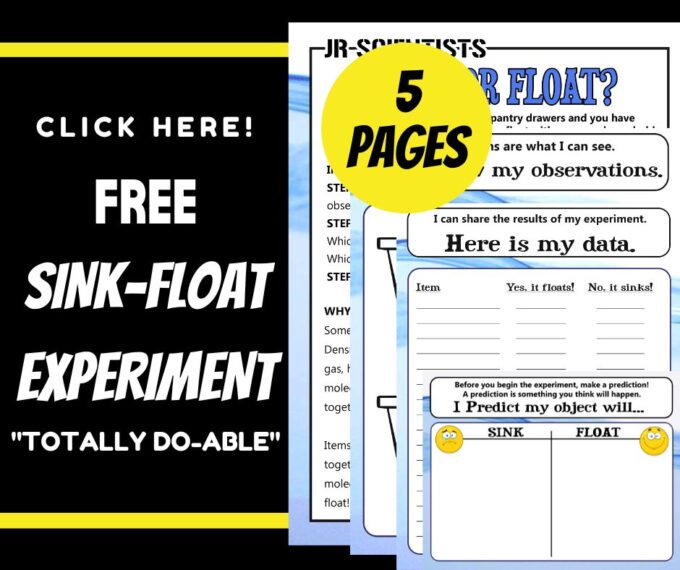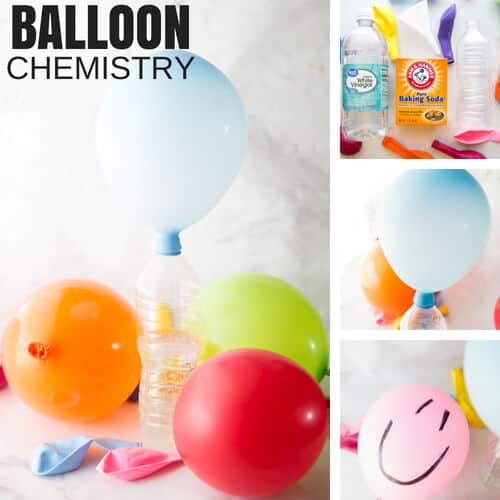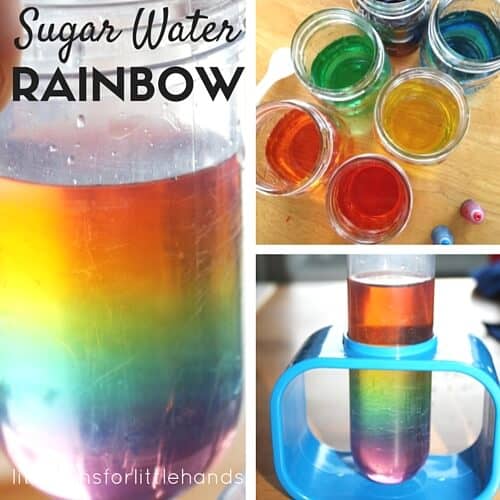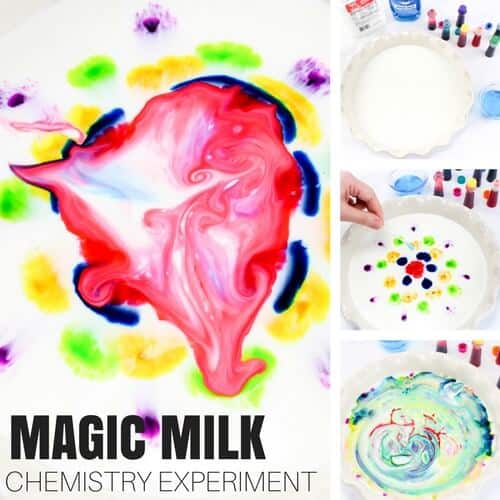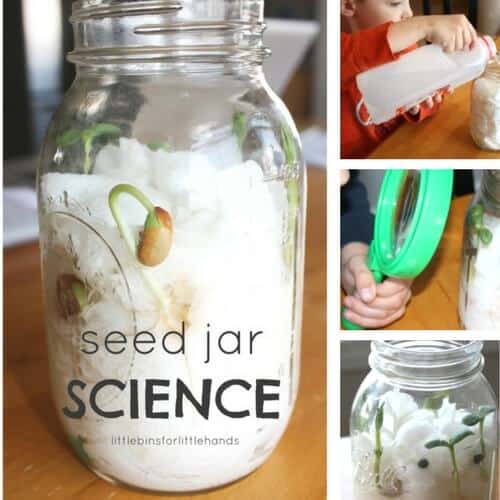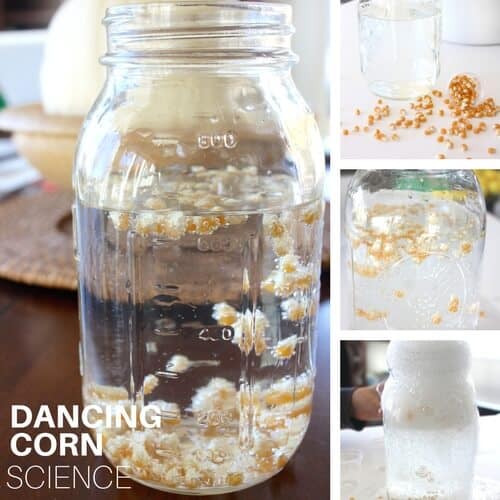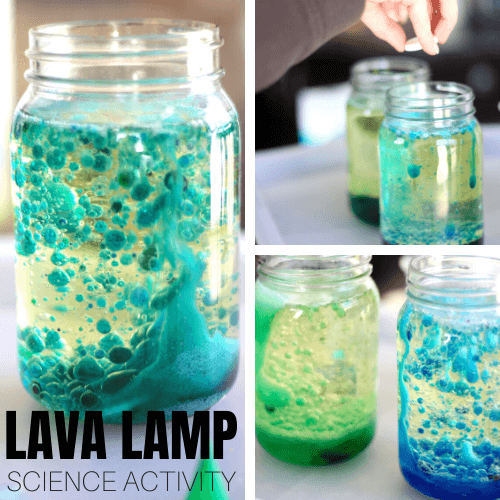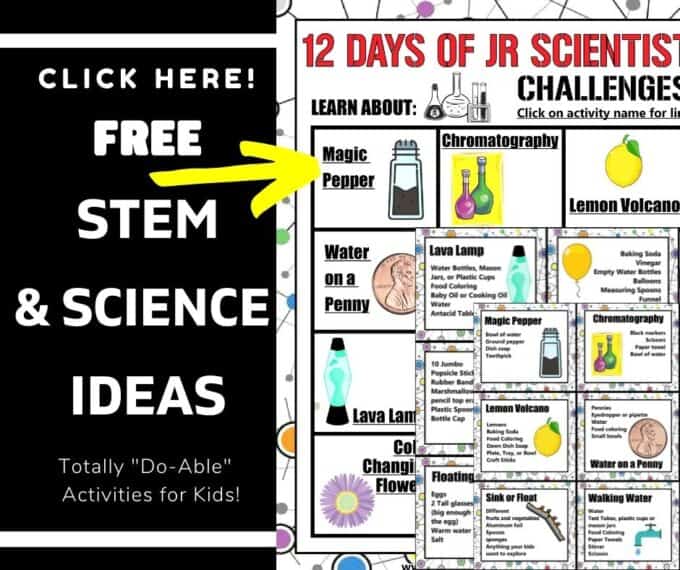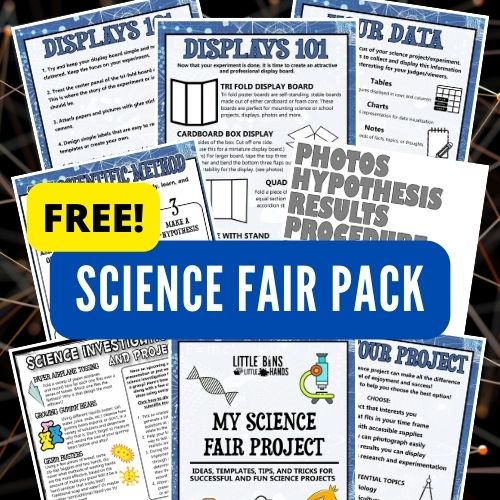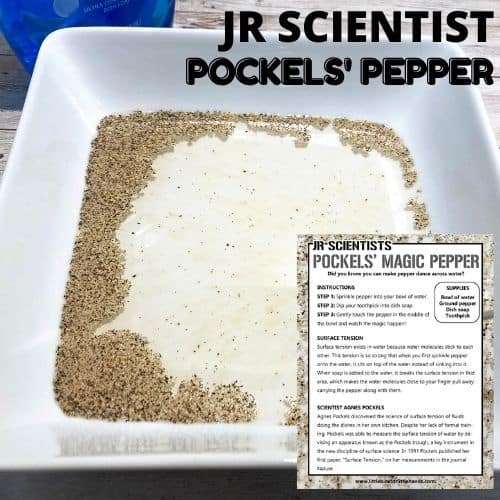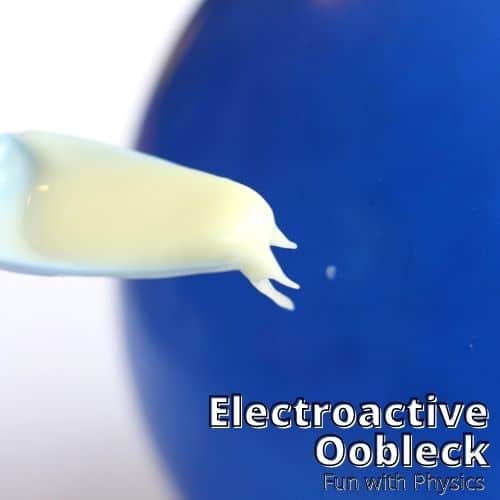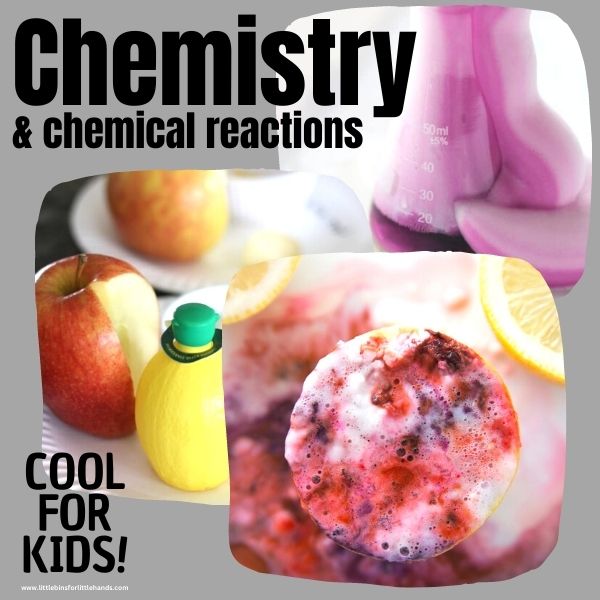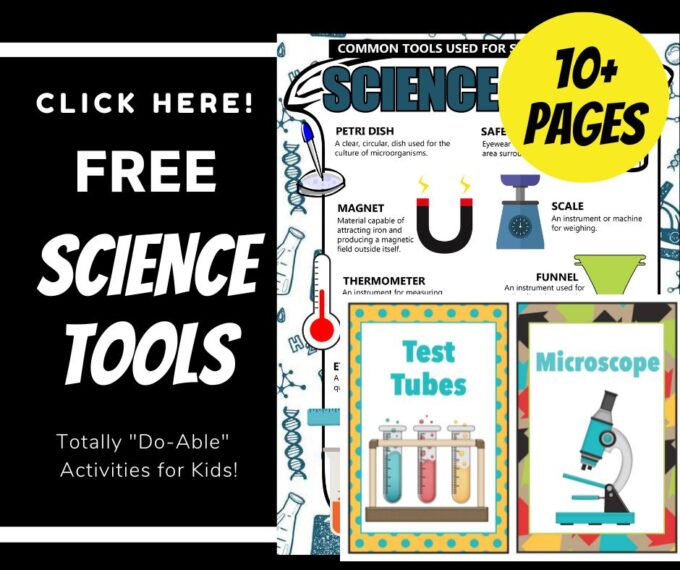Science doesn’t need to be complicated. These easy science experiments below are awesome for kids! Divided into themes, topics, seasons, and holidays, you can get started today! They are visually stimulating, hands-on, and sensory-rich, making them fun to do and perfect for teaching simple science concepts at home or in the classroom. Also, check out our top STEM activities and best science resources!
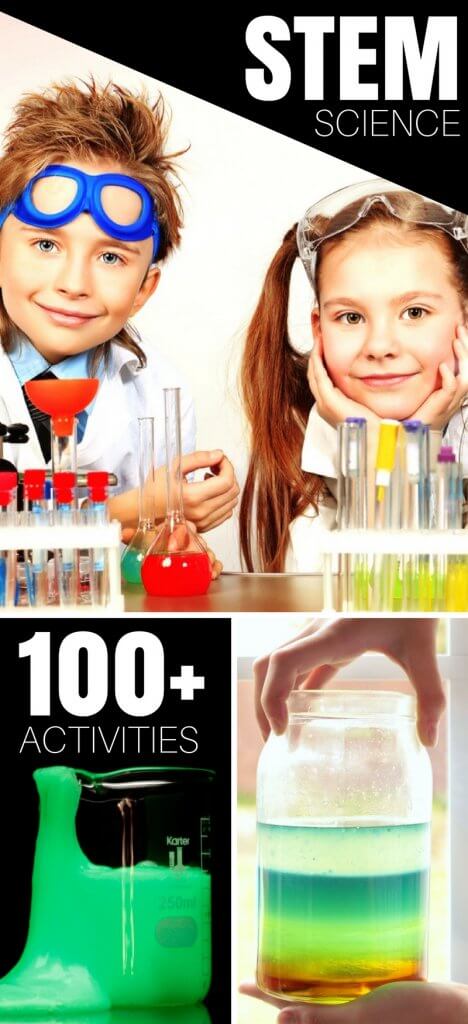
Easy Science Projects To Try
Jump into science with these favorite science experiments and use them right through from preschool to middle school! These easy science projects use household items, include a bit of play, and don’t require exact measurements or steps.
- Oobleck (Non-Newtonian Fluids)
- Baking Soda and Vinegar (always a crowd-pleaser)
- Catapults (fantastic physics)
- Rubber Eggs (it’s a mystery)
- Lava Lamps (very cool chemistry)
If you’re looking for the easiest science experiment you can do with kids at home or in the classroom, look no further than the classic sink or float experiment. Grab the FREE printable science worksheets below to get you started.
Top 10 Science Experiments
Here are our suggestions if you only have time for one or two science experiments. Our top 10 science experiments for kids are our most popular science experiments of all time and have been done again and again! You will even find some fun theme variations for a few of these kids’ science projects.
Click on the titles below to get the full supplies list and easy step-by-step instructions. Have fun trying these experiments at home or in the classroom, or even use them for your next science fair project!
1. Baking Soda Balloon Experiment
Can you make a balloon inflate on its own? Just a few simple ingredients from the kitchen, baking soda and vinegar, and you have amazing chemistry for kids at your fingertips.
We also have a fun Halloween balloon experiment and a Valentine balloon experiment.
2. Rainbow In A Jar
Enjoy finding out about the basics of color mixing all the way up to the density of liquids with this one simple water density experiment. There are even more ways to explore rainbows here with walking water, prisms, and more.
3. Magic Milk
This color-changing magic milk experiment is an explosion of color in your dish. Add dish soap and food coloring to milk for cool chemistry!
We even have done it as a Christmas experiment and for St Patrick’s Day science.
4. Seed Germination Experiment
Not all kid’s science experiments involve chemical reactions. This science experiment for kids is lots of fun because they can see how a seed grows for themselves. It is also a great experiment to introduce the scientific method to kids, as it is easy to vary the conditions the seeds grow under.
5. Egg Vinegar Experiment
One of our favorite science experiments is also called a naked egg or rubber egg experiment. Can you make your egg bounce? What happened to the shell?
6. Dancing Corn
Find out how to make corn dance with this easy experiment. Also check out our dancing raisins and dancing cranberries.
7. Grow Crystals
Growing borax crystals on seashells is actually very easy to do and is a great way to learn about solutions. You could also grow sugar crystals or salt crystals.
Growing crystals is great for themed science. Check out these fun ideas…
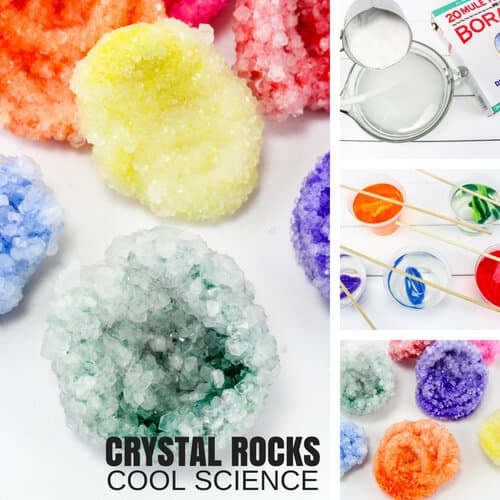
8. Lava Lamp Experiment
Great for learning about what happens when you mix oil and water. A cool science experiment kids will want to do again and again!
Check out these fun variations…
9. Skittles Experiment
Who doesn’t like doing science with candy? Try this classic skittles science experiment and explore why the colors don’t mix when added to water.
10. Lemon Volcano
Watch your kids’ faces light up and their eyes widen when you test out cool chemistry with common household items, baking soda and vinegar.
We have so many fun variations of this fizzing, erupting chemical reaction you will want to try. Check out a few below…
Free Science Ideas Guide
Get Started With A Science Fair Project
Want to turn one of these fun and easy science experiments into a science project? Then you will want to check out these helpful resources.
50 Easy Science Experiments For Kids
Learn about the patina of pennies with this green pennies experiment.
Explore sound and vibrations when you try this fun dancing sprinkles experiment with the kids.
Explore how some liquids are heavier or denser than other liquids with this super easy liquid density experiment.
Grab some bread and try this fun germ science experiment or this bread mold experiment.
Transform ordinary spinach into glowing spinach under ultraviolet light.
Investigate whether an orange will sink or float in water, and learn about density and buoyancy.
Make pepper dance across the water with this easy pepper and soap experiment.
Grab some marbles and find out which one will fall to the bottom first with this easy viscosity experiment.
Can you blow up a balloon with just salt and soda?
Watch this foaming eruption when you add mentos and diet coke.
Test how strong an egg is with this eggshell strength experiment.
Pull out the bin of markers and search for the black ones to get started with this fun chromatography lab.
Just a few common ingredients and you are well on your way to ooohhhs and aaahhhs with this Alka seltzer science experiment.
Explore friction with this easy floating rice experiment.
Find out how to make the water level rise with a burning candle in water.
Electric cornstarch is perfect as an experiment to demonstrate the power of attraction (between charged particles, that is!)
Love fizzing and exploding experiments? Try this erupting mentos and soda experiment.
Explore changes in air pressure with this crushing soda can experiment.
Does color affect taste? Find out with this fun color taste test experiment.
Can you inflate a balloon with just pop rocks and soda?
Try this cool pop rocks experiment that explores viscosity and the sense of hearing.
Explore what happens to ivory soap in the microwave with this expanding ivory soap experiment.
Test out your sense of smell with a citric acid experiment.
Create a frothing brew with this cool elephant toothpaste experiment.
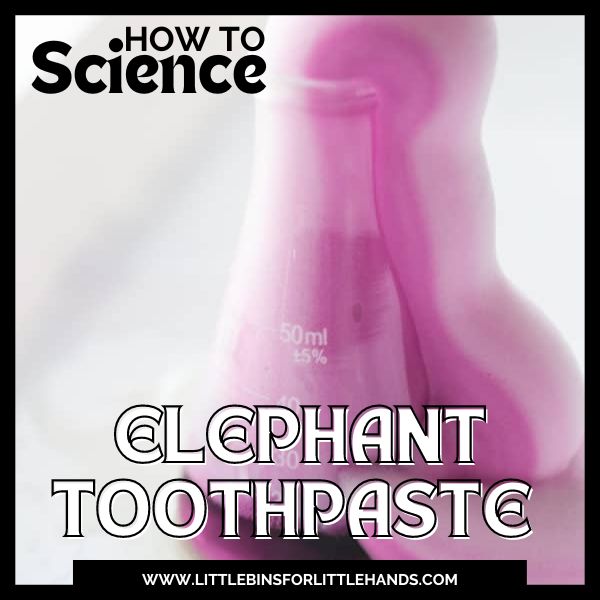
Try a fun gummy bear experiment all in the name of science and learning.
Explore what solids dissolve in water and what don’t with this easy water experiment.
Try this very simple to set up solid, liquid, gas experiment.
Learn about what happens when you mix oil and water together with this oil and water experiment.
Mix up your own bubble recipe and get blowing. Learn about bubbles with these bubble science experiments.
This easy viscosity experiment looks at different liquids from around the house and compares them to each other.
Make an awesome foam with this yeast and hydrogen peroxide experiment.
How do whales stay warm? Test out how blubber works with this hands-on blubber experiment.
Learn about ocean pollution with an easy oil spill experiment.
Can you make a floating drawing? Try this simple dry-erase marker experiment.
Power a light bulb with a lemon battery.

Make a homemade lava lamp with salt.
Will it freeze? What happens to the freezing point of water when you add salt?
Learn about osmosis when you try this fun potato osmosis experiment with the kids.
Make your own magnifying glass from a few simple supplies.
Can you make a paperclip float on water? Try this fun floating paperclip experiment!
Turn water vapor into ice when you make frost on a can.
Investigate what type of sponge holds the most water with sponge absorption experiment.
You will love the noise you can make with this screaming balloon experiment.
Make homemade oil and vinegar dressing for fun chemistry you can eat.
Explore the plant pigments in leaves with this leaf chromatography experiment.
Write a secret message with homemade invisible ink.
Make red cabbage indicator and test the pH of different solutions.
Explore how changes in pressure can suck an egg into a bottle.
Explore how your lungs work with a lung model or your heart with this heart model.
Kids’ Science Experiments By Topic
Looking for a specific topic? Check out these additional resources below. Each topic includes easy to understand information, everyday examples and additional hands-on activities and experiments for you to use.
- Chemistry Experiments
- Physics Experiments
- Chemical Reaction Experiments
- Candy Experiments
- Plant Experiments
- Kitchen Science
- Water Experiments
- Baking Soda Experiments
- States Of Matter Experiments
- Physical Change Experiments
- Chemical Change Experiments
- Surface Tension Experiments
- Capillary Action Experiments
- Weather Science Projects
- Geology Science Projects
- Space Activities
- Simple Machines
- Static Electricity
- Potential and Kinetic Energy
- Gravity Experiments
Fun Science Experiments With A Holiday Theme
Choose a classic science experiment and give it a holiday theme twist with one of these:
Science Experiments By Season
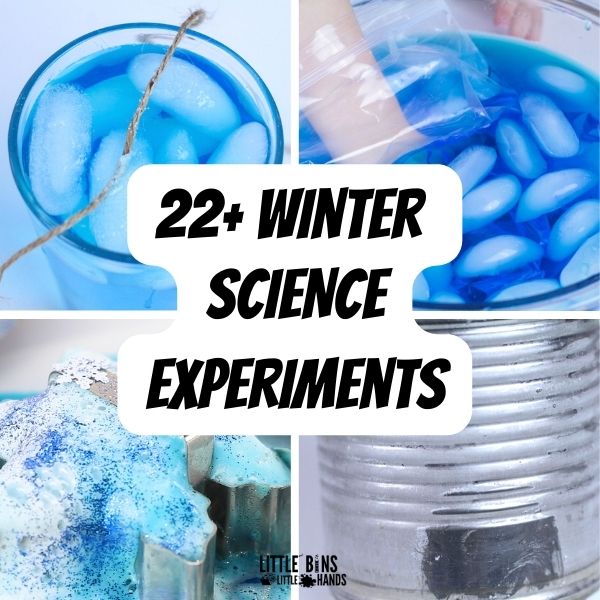
How To Teach Science
Kids are curious and always looking to explore, discover, check out, and experiment to discover why things do what they do, move as they move, or change as they change! My son is now 13, and we started with simple science activities around three years of age with simple baking soda science.
Here are great tips for making science experiments enjoyable at home or in the classroom.
Safety first: Always prioritize safety. Use kid-friendly materials, supervise the experiments, and handle potentially hazardous substances yourself.
Start with simple experiments: Begin with basic experiments (find tons below) that require minimal setup and materials, gradually increasing complexity as kids gain confidence.
Use everyday items: Utilize common household items like vinegar and baking soda, food coloring, or balloons to make the experiments accessible and cost-effective.
Hands-on approach: Encourage kids to actively participate in the experiments rather than just observing. Let them touch, mix, and check out reactions up close.
Make predictions: Ask kids to predict the outcome before starting an experiment. This stimulates critical thinking and introduces the concept of hypothesis and the scientific method.
Record observations: Have a science journal or notebook where kids can record their observations, draw pictures, and write down their thoughts. Learn more about observing in science. We also have many printable science worksheets.
Theme-based experiments: Organize experiments around a theme, such as water, air, magnets, or plants. Even holidays and seasons make fun themes!
Kitchen science: Perform experiments in the kitchen, such as making ice cream using salt and ice or learning about density by layering different liquids.
Create a science lab: Set up a dedicated space for science experiments, and let kids decorate it with science-themed posters and drawings.
Outdoor experiments: Take some experiments outside to explore nature, study bugs, or learn about plants and soil.
DIY science kits: Prepare science experiment kits with labeled containers and ingredients, making it easy for kids to conduct experiments independently. Check out our DIY science list and STEM kits.
Make it a group effort: Group experiments can be more fun, allowing kids to learn together and share their excitement. Most of our science activities are classroom friendly!
Science shows or documentaries: Watch age-appropriate science shows or documentaries to introduce kids to scientific concepts entertainingly. Hello Bill Nye and the Magic Schoolbus! You can also check out National Geographic, the Discovery Channel, and NASA!
Ask open-ended questions: Encourage critical thinking by asking open-ended questions that prompt kids to think deeper about what they are experiencing.
Celebrate successes: Praise kids for their efforts and discoveries, no matter how small, to foster a positive attitude towards science and learning.
Free Science/STEAM Cards- Instant Download today!
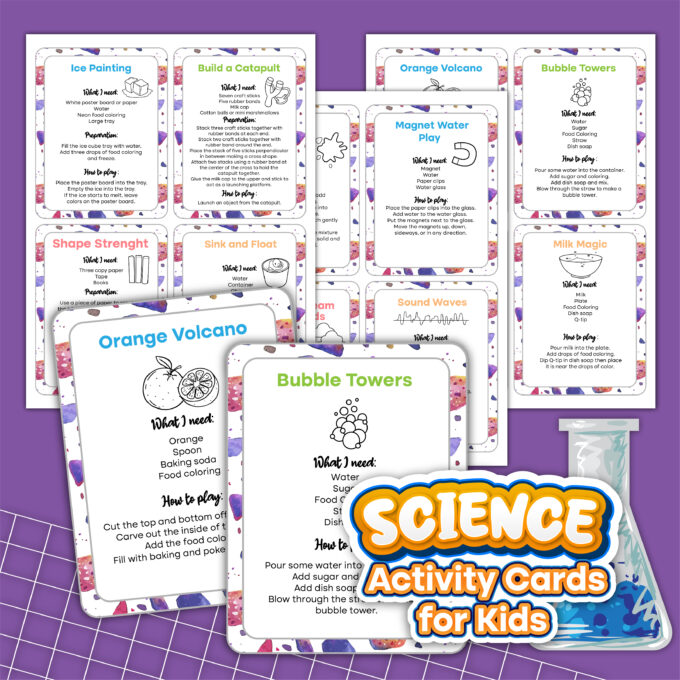
Science Experiments by Age Group
While many experiments can work for various age groups, you will find the best science experiments for specific age groups below.
- Science Activities For Toddlers
- Preschool Science Experiments
- Kindergarten Science Experiments
- First Grade Science Projects
- Elementary Science Projects
- Science Projects For 3rd Graders
- Science Experiments For Middle Schoolers
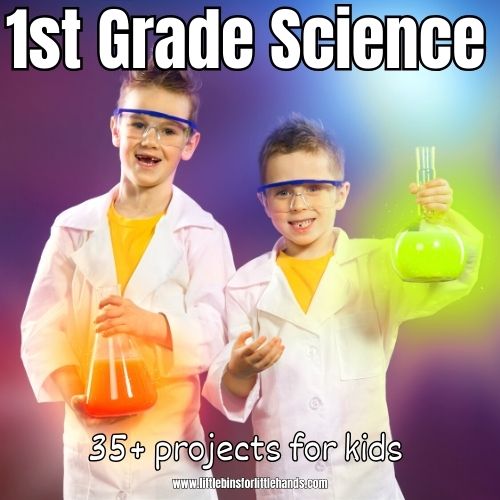
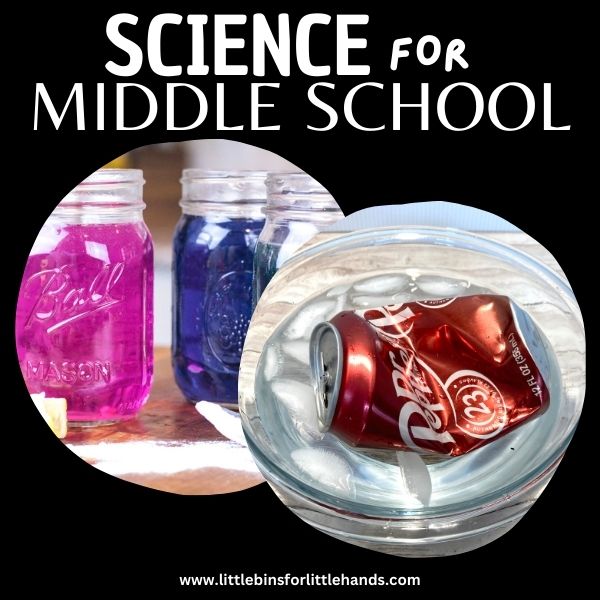
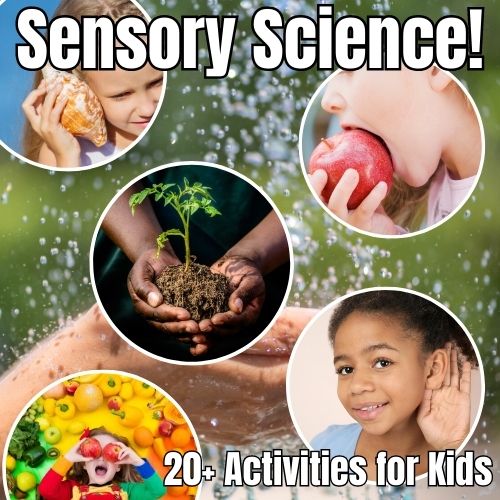
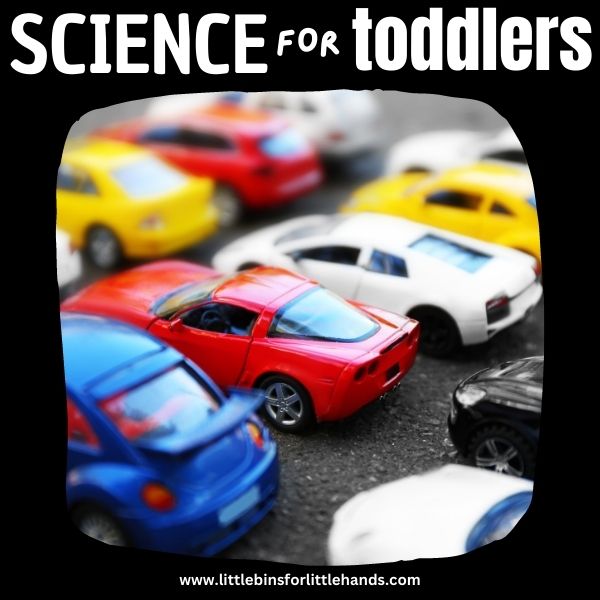

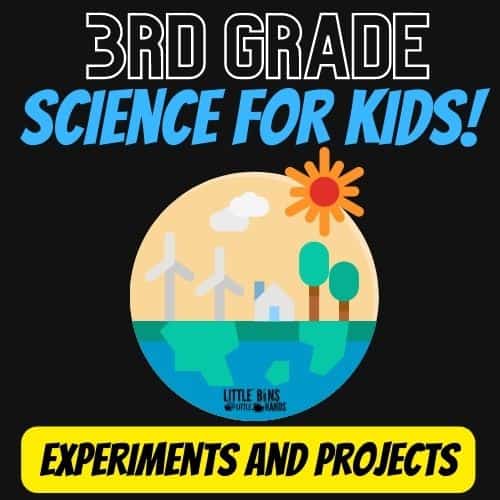
Free Science Journal Worksheets
Create a science notebook with these easy-to-use science worksheets to accompany any experiment. Grab your free science process journal pack!
What is the Scientific Method for Kids?
The scientific method is a way scientists figure out how things work. First, they ask a question about something they want to know. Then, they research to learn what’s already known about it. After that, they make a prediction called a hypothesis.
Next comes the fun part – they test their hypothesis by doing experiments. They carefully observe what happens during the experiments and write down all the details. Learn more about variables in experiments here.
Once they finish their experiments, they look at the results and decide if their hypothesis is right or wrong. If it’s wrong, they devise a new hypothesis and try again. If it’s right, they share their findings with others. That’s how scientists learn new things and make our world better!
Go ahead and introduce the scientific method and get kids started recording their observations and making conclusions. Read more about the scientific method for kids.
More Helpful Science Resources
Use the resources below to complement the many science activities on our website. You’ll find a fantastic free printable for each one.
SCIENCE VOCABULARY
It is never too early to introduce some fantastic science words to kids. Get them started with a printable science vocabulary word list. You’re definitely going to want to incorporate these simple science terms into your next science lesson!
WHAT IS A SCIENTIST
Think like a scientist! Act like a scientist! Scientists, like you and me, are also curious about the world around them. Learn about the different types of scientists and what they do to increase their understanding of their specific area of interest. Read What Is A Scientist
SCIENCE BOOKS FOR KIDS
Sometimes the best way to introduce science concepts is through a colorfully illustrated book with characters your kids can relate to! Check out this fantastic list of science books that are teacher approved and get ready to spark curiosity and exploration!
SCIENCE PRACTICES
A new approach to teaching science is called the Best Science Practices. These eight science and engineering practices are less structured and allow for a more free–flowing approach to problem-solving and finding answers to questions. These skills are critical to developing future engineers, inventors, and scientists!
DIY SCIENCE KIT
You can easily stock up on the main supplies for dozens of fantastic science experiments to explore chemistry, physics, biology, and earth science with kids in preschool through middle school. See how to make a DIY science kit here and grab the free supplies checklist.
SCIENCE TOOLS
What tools do most scientists commonly use? Grab this free printable science tools resource to add to your science lab, classroom, or learning space!
Bonus STEM Projects For Kids
STEM activities include science, technology, engineering and mathematics. As well as our kids science experiments, we have lots of fun STEM activities for you to try. Check out these STEM ideas below…
- Building Activities
- Self-Propelling Car Projects
- Engineering Projects For Kids
- What Is Engineering For Kids?
- Lego Build Ideas
- Coding Activities For Kids
- STEM Activities For Toddlers
- STEM Worksheets
- Top 10 STEM Activities For Kids
- STEAM = Art + Science
- Easy STEM Activities For Elementary
- Quick STEM Challenges
- Easy STEM Activities With Paper


